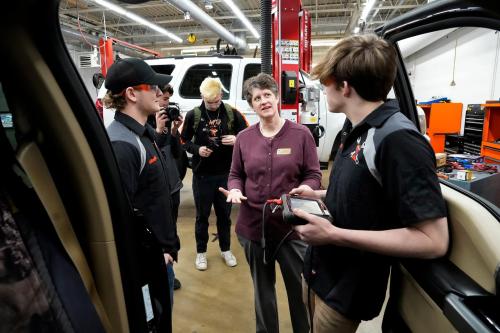If you want more content like this, subscribe to our newsletter.
This week in Class Notes:
-
- Accounting for the consumption value of college increases the rate of return to a college education by 12-14%.
- Virtual college counseling increases applications to four-year and selective universities, particularly among disadvantaged students, but the effect on acceptance and enrollment is minimal.
- Automatically enrolling employees into an employer-sponsored savings account is a cost-effective way of helping workers accumulate savings, and 401(k) accounts, Roth IRAs, and depository institution accounts are all viable options.
- Our top chart shows the increase in take-up rates of paid family leave following the passage of California’s 2004 Paid Family Leave Act.
- According to The Economist, wealth and income inequality may be lower than popularly believed.
- Finally, check out Marcus Casey’s new piece exploring how advancements in artificial intelligence could improve the quality of work – with the right policies in place.
The consumption value of college
Why go to college? The typical answer is that it is an investment in a better career after graduation. But there are more immediate benefits (and costs) too. In this study, Gong et al. present the first attempt to quantify the full “consumption” benefits of college, including easy access to athletic facilities on campus and free leisure and entertainment opportunities. Looking exclusively at Berea College, the authors find a substantial consumption value of college, with the average annual value ranging from $9,900 to $11,600. These sizeable benefits are consistent with other survey responses in which roughly 80% of Berea freshman indicate that they enjoy college more than they think they would enjoy not being in college. Accounting for these additional benefits increases the average rate of return to a college education by 12-14%. However, the authors do document significant heterogeneity in consumption value across students.
Does virtual advising increase college enrollment? Evidence from a random assignment college access field experiment
Despite the benefits of a college education, students from economically disadvantaged families are significantly less likely to attend college than their more advantaged peers. This disparity suggests that low-income students face more barriers to college attendance than their higher-income peers. In this paper, Meredith Phillips and our colleague Sarah Reber evaluate the effects of a virtual college-counseling intervention designed to reduce informational and social support barriers to college application and enrollment among disadvantaged students. The authors show that students who were randomly assigned to the program felt more supported during the college application process and applied more broadly to four-year colleges.
Furthermore, the program was particularly effective at increasing applications to four-year and selective colleges among students whose parents were unable to help with the applications and those who tended to procrastinate. However, these students were generally not more likely to be accepted or enroll. The authors conclude that these sort of “low-touch” programs may work for some students, but many will likely need intensive, in-person advising to increase four-year enrollment rates.
Building emergency savings through employer-sponsored rainy-day savings accounts
Many Americans live paycheck to paycheck, carry a credit card balance, and have limited resources for absorbing financial shocks. An unfortunate consequence of this financial instability is that many working-age employees turn to their retirement savings in the event of an emergency. Beshears et al. explore three specific implementation options for employer-sponsored emergency savings accounts (a) after-tax employee 401(k) accounts, (b) deemed Roth IRAs under a 401(k) plan, and (c) depository institution accounts. The authors conclude that automatically enrolling employees into an employer-sponsored savings account is a cost-effective way of helping workers accumulate savings and that 401(k) accounts, Roth IRAs, and depository institution accounts all warrant further research.
Top chart
In 2004, California introduced a policy allowing for six weeks of bonding leave for new parents. This week’s top chart shows that this change spurred many more women to take paid leave. Indeed, mothers exposed to the policy change after 2004 were 18 percentage points more likely to use paid leave than similar women who were not exposed to the change prior to that year.

Choice opinion
“Will this flurry of new research change people’s minds about inequality? That will depend, ultimately, on which scholars prevail as economists thrash out the various debates…And even if inequality has not risen by as much as many people think, the gap between rich and poor could still be dispiritingly high. While that long and bloody academic battle takes place, it would be wise for policymakers to proceed cautiously. Proposals for much heavier taxes on high earners, or a tax on net wealth…are responses to a problem that is only partially understood” writes an anonymous contributor in The Economist.
Self-promotion
Will automation and artificial intelligence make middle class jobs worse, better, or irrelevant? The short answer is that we don’t know for sure. But it is clear that the adaptation of workers and communities will depend on how far – and how quickly –policymakers, private institutions, and businesses support them. In his new piece “How automation could make some jobs better,” Marcus Casey outlines the most important steps policymakers can take in this direction – improving education and training for workers, valuing human capital in the tax code, incentivizing innovation that enhances complementarity not substitution, and reintroducing workers as stakeholders.
If you want more on this topic, be sure to tune in to our automation conference on December 12th, where we will be discussing new research examining how advancements in AI are interacting with labor market institutions and features, including the minimum wage, the Earned Income Tax Credit, and labor unions.








Commentary
Class Notes: Virtual college counseling, rainy-day savings accounts, and more
Wednesday, December 11, 2019